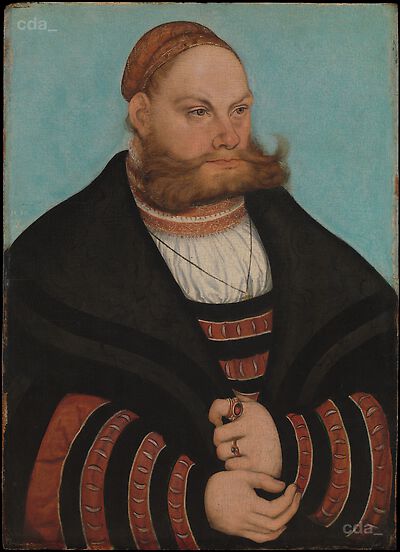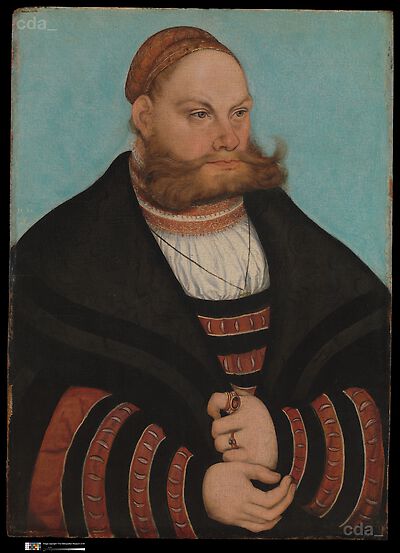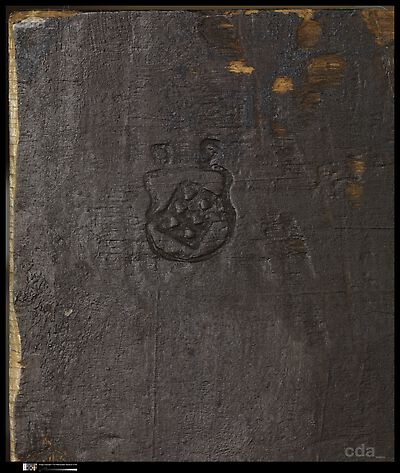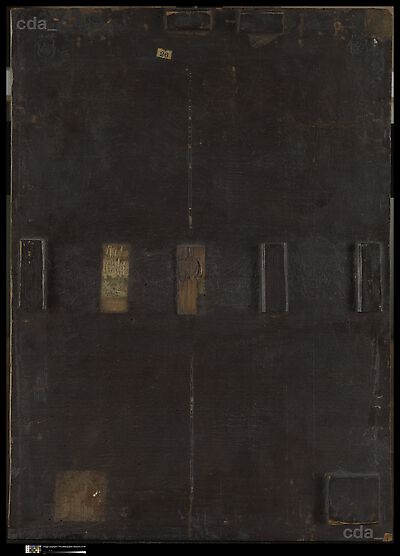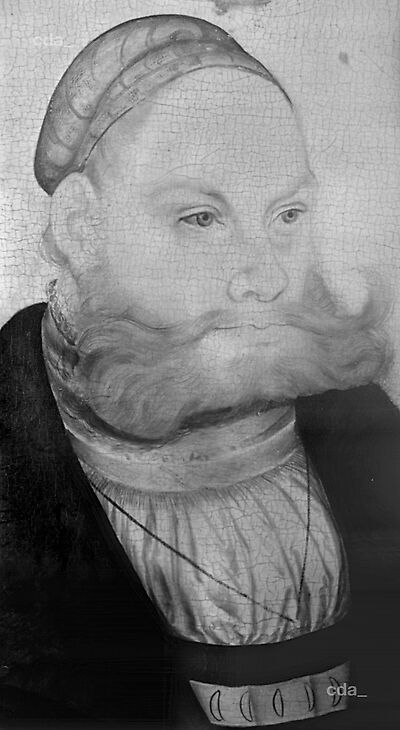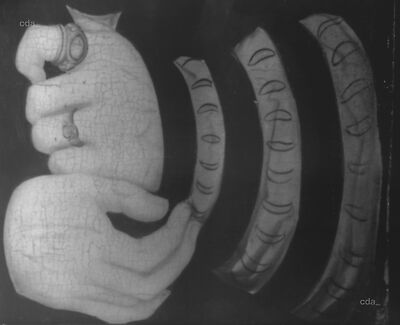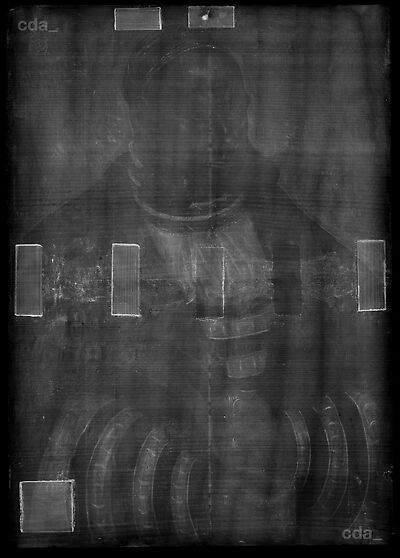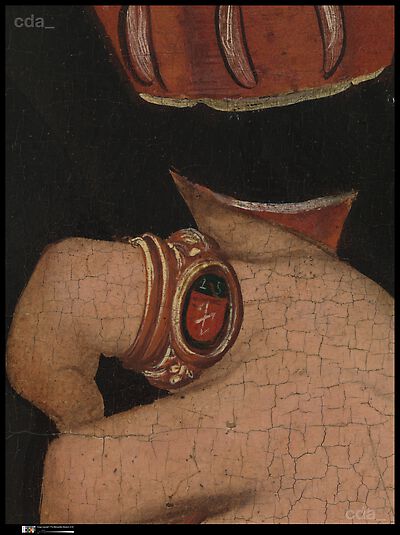The Museum’s portrait was first published in 1916, when it appeared at auction as a work of Lucas Cranach the Elder.[1] The attribution was later affirmed by Heinrich Zimmermann and by Max J. Friedländer and Jakob Rosenberg.[2] Possibly because it remained in private ownership until 1981,[3] the panel received relatively little attention in the Cranach literature. Stylistically, it is consistent with other Cranach portraits of the early 1530s, such as Portrait of a Man with a Beret of 1532 (formerly Alfredo Hirsch Collection, Buenos Aires), Portrait of a Man with a Rosary of the same year (Kirchenkreis Alt-Hamburg), and Chancellor Gregor Brück of 1533 (Germanisches Nationalmuseum, Nuremberg) [DE_BRD-GNMN_Gm1649].[4] The underdrawing, which consists of thin, sparingly applied contour lines in the face and hands, compares well with the type found in the portrait of Brück.[5] The X-radiograph reveals an economy of means in the buildup of the paint layers, especially in the thin flesh tones (fig. 57). The deft and confident execution of this painting elevates it above the level of routine shop production and suggests that it is mostly the work of Cranach himself. The lively pattern of colors in the costume and the interplay of curves throughout give this portrait an especially striking visual impact.
A clue to the identity of the sitter may be provided by the coat of arms of the Spielhausen family on the panel’s verso (fig. 59).[6] One intriguing possibility, suggested by the initials LS on the signet ring, is that he is Lukas Spielhausen. Born about 1493 in Leipzig, where he took a doctorate in law in 1524, Spielhausen was by 1531 Hofprokurator in the electoral residence of Torgau, that is, a lawyer in the state judicial curia under Johann the Constant, Elector of Saxony (r. 1525 – 32).[7] In 1544 Spielhausen gained citizenship in Weimar, where he held several positions in the municipal administration, including that of mayor, before his death in 1558.[8] The initials DS above the Spielhausen coat of arms on the back of the panel add further support to the identification, since they could refer to Lukas Spielhausen’s grandson David, who died in or before 1607, as a possible owner of the painting.[9]
Spielhausen’s age of approximately thirty-nine in 1532, the date of the portrait, is compatible with the appearance of the sitter. He could have encountered Cranach, court painter to the Saxon electors, through his official duties in Torgau. It remains to be discovered whether the Wolfsangel on the signet ring was a personal insignia of Spielhausen, one that he might have used separately from the family coat of arms with the playing card. Spielhausen’s only documented marriage was in 1541;[10] thus, if he is indeed portrayed here, the present work was likely an isolated portrait without a female pendant.
[1] Helbing 1916, vol. 1, p. 154, no. 1042.
[2] H. Zimmermann 1925, p. 111; Friedländer and J. Rosenberg 1932, p. 79, no. 273; Friedländer and J. Rosenberg 1978, p. 136, no. 339. See also Garner 1926, pp. 54 – 55 (erroneous identification of the sitter as Duke Johann Friedrich the Magnanimous); Heyck 1927, pp. 96, 119; Kuhn 1936, p. 43, no. 132; Lilienfein 1942, p. 70; H. Zimmermann 1962, p. 10.
[3] See Mary Sprinson in Metropolitan Museum 1981, p. 43.
[4] Friedländer and J. Rosenberg 1978, p. 136, no. 340 (formerly Buenos Aires), ill., no. 340A (Hamburg), no. 341 (Nuremberg), ill. For an illustration of the Hamburg portrait, see most recently Ahuis 2011, fig. 4.
[5] Described in Löcher 1997, p. 150; illustrated in Eisenach 1998, p. 134, fig. 15.3a.
[6] See Siebmacher 1856 – 1967 (ed.), vol. 6, pt. 12 (1907), p. 84, and pl. 66. The painting may formerly have borne an inscription in the upper right giving the sitter’s name. An illegible inscription is visible in the illustration in Helbing 1916, vol. 2, pl. 142. By 1924, however, it had been excised; see Kleykamp 1924, no. 7, ill.
[7]. Eichbaum 2005, p. 14, no. 12660; I thank Gustaf-Götz Eichbaum for kindly providing biographical information based on his research (email to the author, October 24, 2007, curatorial files, Department of European Paintings, MMA). The black and orange color scheme of the costume may allude to the black and yellow heraldic colors of Saxony, suggesting that the sitter was a ducal official, as was Spielhausen. As Helmut Nickel noted in regard to the question of orange versus yellow, the costume’s orange could have been regarded as rotes Gold (red gold), a contemporary expression for gold, which in heraldic terms is equivalent to yellow; see Helmut Nickel, email to Mary Sprinson de Jesús, September 19, 2006 (curatorial files, Department of European Paintings, MMA). For examples of rotes Gold standing for Gold, see J. Grimm and W. Grimm 1854 – 1971 /1998 –, s.v. “Gold,” sec. 3, I, A., 1, a” (accessed April 23, 2012).
[8] According to Gustaf-Götz Eichbaum, on information from the Stadtarchiv Weimar, in 1609 the Weimar city council ordered a posthumous portrait of Spielhausen from the painter Martin Lamprecht, but whether this work still exists is unknown (email to the author, December 18, 2007, curatorial files, Department of European Paintings, MMA).
[9] David, mayor of Salzungen near Eisenach, was the son of Lukas’s son David Daniel, who died in 1587; this information was kindly provided by Jan Lekschas, Bernau (email to the author, December 8, 2008, curatorial files, Department of European Paintings, MMA). David and David Daniel Spielhausen are not recorded in Eichbaum 2005. David Spielhausen’s date of death can be inferred from the title page of a 1607 publication referring to him as deceased: Gamelia in honorem nuptiarum Praestantiß. variarumque rerum usu peritißimi viri Dn. Georgii Fulden . . . sponsi cum . . . Virgine Regina . . . Dn. Davidis Spielhausen, olim quaesturae Saltzungensis praefecti fidelissimi, p. m. relicta filia, sponsa ( Jena, 1607). A Spielhausen six-of-hearts seal dating from 1582 with the initials DS, thus perhaps belonging to David Spielhausen, is described by a Freiherr von Ledebur in Der Deutsche Herold 38, no. 5 (1907), p. 92.
[10] Eichbaum 2005, p. 14, nos. 12660, 12661 (Margaret Zahn).
[Waterman, Cat. New York 2013, 66, 68, 288, No. 14]
